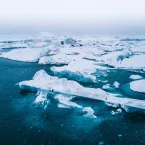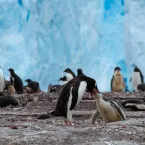Our Research
As climate changes, how do Earth's frozen areas affect our planet and impact society?
In this section
Related News & Stories
Filter by:

Feature Story
In November 2021, snow in South Greenland shrouded the ground when heavy rain fell, forming an ice crust and stranding hundreds of sheep in the rugged terrain. Most perished following this rain-on-snow event. The international Arctic Rain on Snow Study (AROSS), led by the National Snow and Ice Data Center, had not expected to hear similar stories of livestock decline caused by rain on snow events in southern Greenland like they had been hearing about in Alaska, Lapland, and Russia. The event in South Greenland marked an opportunity for AROSS to offer knowledge exchange across different cultures, cultural practices, and environments under an increasingly unpredictable climate.

Analysis - Snow Today
Snow-covered area in March across the western United States was 8 percent below average, ranking seventeenth in the 25-year satellite record. Snow cover duration was just above the twenty-fifth percentile. Snow albedo, also known as snow brightness, started low in early March and then oscillated between high, then low, and then high during the month. Snow water equivalent (SWE) relative to average showed little change during the month, despite SWE gains at many stations across the region.

Analysis - Sea Ice Today
Arctic sea ice extent for March set a record low in the 47-year satellite data record. Extent was below average everywhere except the East Greenland Sea.

News Release
Arctic sea ice has likely reached its maximum extent for the year, at 14.33 million square kilometers (5.53 million square miles) on March 22, according to scientists at the National Snow and Ice Data Center (NSIDC) at the University of Colorado Boulder. The 2025 maximum sea ice extent is the lowest in the 47-year satellite record, falling short of the previous record low of 14.41 million square kilometers (5.56 million square miles) set on March 7, 2017.

Analysis - Sea Ice Today
Arctic sea ice extent appears to have reached its annual maximum on March 22, 2025. This is the lowest maximum in the 47-year satellite record, with previous low maximums occurring in 2017, 2018, 2016, and 2015.

Analysis - Ice Sheets Today
Melting on the Antarctic Ice Sheet for the 2024 to 2025 season began with above average melt extents in all regions, but melt extent dropped to nearly zero or below average from February 1 to March 15. Net accumulation of snow, part of the ice sheet’s surface mass balance, was far above average for the year, helping reduce the ice sheet’s net contribution to sea level rise for this period.